
Procedural
Requirements
Effective Date: March 24, 2006
Expiration Date: March 24, 2026

|
NASA Procedural Requirements |
NPR 1450.10D Effective Date: March 24, 2006 Expiration Date: March 24, 2026 |
| | TOC | ChangeHistory | Preface | Chapter1 | Chapter2 | Chapter3 | Chapter4 | Chapter5 | Chapter6 | Chapter7 | Chapter8 | AppendixA | AppendixB | AppendixC | AppendixD | AppendixE | AppendixF | AppendixG | AppendixH | AppendixI | AppendixJ | ALL | |
4.1.1 NASA policy is to use memos for internal (Agency-wide) use only. Letters are used for external and formal use; e.g., congratulations, retirement, condolence. Before preparing memos, study the figures in this chapter. These guidelines are standard features for correct memo formatting of correspondence within and among all NASA Centers, including Headquarters.
4.1.2 Administrator's Correspondence. See Appendix A: Administrator's Correspondence Preparation and Control, for specific instructions on preparing memos for the Office of the Administrator.
4.1.3 Stationery. Prepare all correspondence on official NASA letterhead. Use plain bond paper for succeeding pages. See Appendix A for stationery to be used for officials in the Office of the Administrator.
4.1.4 Font. Times New Roman 12 is preferred. Use script or italic only for occasional emphasis. To prevent a memo from continuing onto a second page, the font size of the type may be slightly reduced.
4.1.5 Ink. Use black or blue-black ink to sign correspondence.
4.1.6 Margins. Set the left margin two spaces to the right of the printed caption "Reply to Attn of:" (1.2 or 1 1/8 inches). Set the right and bottom margins at approximately one inch. Set the top margin at one inch on the second and succeeding pages. Do not justify the right margin.
4.1.7 File Copies. Always prepare an official record copy.
a. Official File Copies. Prepare a white copy visibly marked in the upper right corner "Official File" or "Official Record Copy."
b. Other File Copies. Prepare only the number of copies required for distribution, based on the correspondence practices of the preparing office.
4.1.8 Reply to Attn of: line. For Headquarters correspondence, type the writer's organization title (abbreviation is acceptable) which serves as a basic identification symbol and shall appear on all outgoing correspondence. Centers use office codes.
4.1.9 Dating Correspondence. Type or stamp the date (centered) two lines above the "Reply to Attn of:" line (e.g., August 20, 2005). Do not use military style (e.g., 20 Aug 2005) or endings such as "st" or "th" after the day (e.g., Aug 20th).
4.1.10 Address. Always type the "TO:," "THRU:," "FROM:," and "SUBJECT:" in all caps.
a. TO: Type "TO:" at the left margin, three typing returns below the "Reply to Attn of:" line. Seven spaces after "TO:," type the title of addressee. The use of titles is preferred; however, if an individual does not use a title, it is acceptable to have a memo from a title to a name or from a name to a name (use full name; e.g., Ofc of Education/John A. Smith).
b. THRU: Use the "THRU:" line when one or more addressees are needed to endorse (i.e., approve, concur, coordinate) the document prior to its receipt by the addressee and when the endorsement needs to appear on the original document. The "THRU:" line addressee signs and dates the memo next to his or her name before forwarding. Type "THRU:" directly below the last line of the "TO:" line. Align the addressee information with the "TO:" line above. Single-space between each "THRU:" line addressee.
c. FROM: Type "FROM:" at the left margin, two typing returns below the "TO:" or "THRU:" line. The text aligns with the "TO:" or "THRU:" line. The "FROM:" line includes the office name and title of the signer and should align with the "TO:" or "THRU:" lines. The use of titles is preferred; however, if an individual does not use a title, it is acceptable to have a memo to a title from a name or from a name to a name (use full name; e.g., Ofc of Education/John A. Smith).
d. SUBJECT: Type "SUBJECT:" at the left margin in all caps, two typing returns below the last line of the "FROM:" line. Begin the text of the subject line two spaces after the colon. If more than one line is needed for the subject, begin succeeding lines aligned with the first character of the subject. State concisely the main topic of the memo. If acronyms or abbreviations are used in the subject, spell them out, followed by the acronym in parentheses. If an abbreviation or acronym is frequently used in a memo, establish it in the subject line so that only the shortened form is necessary in the body of the correspondence. Capitalize the first letter of only key words within the subject line.
4.1.11 Reference Line. Avoid a reference line in a business memo, except when it contributes to the understanding of the correspondence and when the number of references is too great to be reasonably incorporated in the first paragraph of the memo. Type "REF:" at the left margin, blocked, two typing returns below the last line of the subject, followed by an itemized listing of the references. Abbreviate items as much as possible; e.g., type dates in numerical figures (4/5/05). List references as (a), (b), (c), single spaced in chronological order with the most recent date listed first. Align the paragraphs with the text in the "SUBJECT:" line. See Figure 4-2 of this chapter.
4.1.12 Body of Memo. Begin typing the body of the memo two lines below the "SUBJECT:" or "REF:" lines. Use single-spaced text, and double-space between paragraphs. Type text paragraphs in block form. When a paragraph is broken into subparagraphs, number and letter the subparagraphs as shown in Chapter 3, Figure 3-2. Hyphenate sparingly to ensure a uniform right margin. Avoid hyphenating more than two consecutive lines. Also, avoid hyphenating at the end of the first line or the end of the last full line of a paragraph.
4.1.13 Widows and Orphans. Do not begin a paragraph near the end of a page unless there is room for at least two lines on that page. Do not continue a paragraph on the following page unless two lines can be carried over to that page.
4.1.14 One-Paragraph Memo. Double-spacing may be used if a memo contains only one paragraph and consists of 10 lines or less. See Figure 4-2 of this chapter.
4.1.15 Succeeding Pages. Type succeeding page(s) of a memo on plain bond paper. Beginning with the second page, type the page number five lines from the top of the page, approximately one inch from the right edge of the page. Continue the body of the memo two lines below the page number. Apply the same margins as those on the first page.
4.1.16 Signature Blocks
a. Format. Type the signature information at the left margin, five typing returns below the last line of text. Type the name of the signing official only. Do not use Mr., Mrs., Ms., or Dr., in the signature block.
b. Acting Official. If it is known before typing that an acting official will sign the memo, type that person's name and the word "Acting" before the title in the "FROM:" line. If the memo has been prepared for the signature of the signing official but is actually signed by another, the person signing will write "for" in front of the typed name. Mark courtesy copies with the actual signer's name to establish for the record which person actually signed.
4.1.17 Enclosures. When an enclosure accompanies a letter, type the word "Enclosure" flush with the left margin, two lines below the last line of the signer's name or title. For consistency, identify either all or none of the enclosures in the text.
a. Enclosures Identified in the Text. When possible, identify enclosures in the text in as few words as possible or by title. If there is more than one enclosure, indicate the number as follows:
3 Enclosures
b. Enclosures Not Identified in the Text. When enclosures are not identified in the text, type the list at the left margin. List each enclosure on a separate line as follows:
Example of unnumbered enclosures:
4 Enclosures:
Form Letters Handbook
Plain Letters Pamphlet
Organizational Chart
The NASA Scientific and Technical Information System Brochure
or
Example of numbered enclosures:
3 Enclosures:
1. Form Letters Handbook
2. Plain Letters Pamphlet
3. Organizational Chart
c. Marking Enclosures. On the first page of each enclosure, the word "Enclosure" should be typed in the lower right corner; e.g., Enclosure, Enclosure 1, Enclosure 2.
4.1.18 Material Sent Under Separate Cover. When material referred to in the text is sent under separate cover, type "Separate Cover:" at the left margin, two typing returns below the signer's title or the "enclosure" notation if there is one. List the material, whether or not it is identified in the text. Send a copy of the memo with the material that is mailed under separate cover. Example:
Separate Cover:
Form Letters Handbook-10 copies
Plain Letters Pamphlet-10 copies
Correspondence Handbook-10 copies
4.1.19 Courtesy Copies.
a. Courtesy Copies (cc:). Type the distribution of courtesy copies on the original when the recipient needs to know who received copies. Type "cc:" at the left margin two typing returns below the last typed line of the signature block, the enclosure line, or separate cover listing. Directly below "cc:," single-space the list of recipients, using office or organizational codes and identifying whether HQ or Center (if applicable).
Examples (listed in order of preference):
cc:
Ofc of the Gen Counsel/Mr. Franklin
Ofc of the Gen Counsel/Mr. E. Franklin
Ofc of the Gen Counsel/E. Franklin
Examples of designating officials in an "Acting" capacity:
CIO/Mr. Smith (Acting)
CIO/Mr. M. Smith (Acting)
CIO/M. Smith (Acting)
A dual-column "cc:" distribution list is permitted when the list is too long to fit in a single column on one page.
b. Preferred Order. The following example provides the correct order of recipients of courtesy copies. If the memo has enclosures, indicate any recipients who were not sent enclosures by typing the notation "(w/o encl.)" after their names.
Example:
| cc: | |
|---|---|
| HQ/Ofc of Institutions and Mgmt/Dr. Warren | 1. Originator's addressees first.* |
| HQ/Ofc of Space Ops/Ms. Olsen | |
| HQ/Ofc of the IG/Ms. Ledford | 2. Headquarters addressees next.* |
| HQ/Exploration Sys Missions Directorate/Mr. Owens | |
| HQ/Ofc of Public Affairs/Mr. Sullivan | |
| HQ/Ofc of Ext Relations/Ms. Irwin | |
| ARC/200-2/Ms. Jaynes | 3. Centers' codes next.* |
| ARC/233-14/Ms. Chenier | |
| DFRC/O/Ms. Rudy | |
| JSC/AA/Ms. Womack | |
| JSC/AC/Ms. Marshall | |
| **DOC/Mr. Lancaster (w/o encl.) | 4. Federal agencies next. * |
| **DOT/Mr. Smith | |
| *GSA/Mr. Merman (w/o encl.) | |
| Johns Hopkins University/Dr. Reader | 5. Non-Federal organizations last.** |
| Seattle, WA/Mr. Jones |
*All lists should be in seniority order if known. Otherwise they should be listed alphabetically and numerically.
**If an organizational acronym is used without first spelling it out, it should be well known to the recipient of the memo.
c. Blind Courtesy Copies (bcc:). Use blind courtesy copies when the recipient does not need to know who received copies or to document the office of record. Type "bcc:" on the official file copy two typing returns below the "cc:" listing. Never type "bcc:" on the original. The list should include the official file copy with the Agency filing scheme number from Appendix A of NPR 1441.1. If the memo has enclosures, indicate any recipients who were not sent enclosures by typing the notation "(w/o enclosure)" or "(w/o encl.)" after their names or organizations. Identifying "bcc:" recipients and using dual-column "bcc:" lists will follow the same guidelines as stated in Chapter 3, paragraph 3.1.23.a. Example:
bcc:
Ofc of Procurement/Mr. Sullivan
OLA/Official File 1330
OLA/Reading File (w/o enclosure)
4.1.20 Official Record Copy Preparation. The official record copy includes all relevant drafting information concerning the correspondence.
a. Identification of Office, Writer, and Typist.
(1) On the bottom of file copies of the signature page, type the organization of the preparing office, the writer's first initial and surname, the typist's initials, date of typing, and the writer's telephone extension. Example: OLA/JSmith:abd:2/20/05:1234
(2) If the memo is rewritten or retyped, type a second identification line directly below the first. Example:
OLA/JSmith:abd:2/20/05:1234
Rewritten: OLA/EJones:olr:2/28/05:8135
Retyped:OLA/sdf:3/5/05:1024
b. NPD 1440.6, NASA Records Management, and NPR 1441.1, contain the NASA numbering system for indexing files. Type the official file number on all file copies as indicated in paragraph 4.1.20.a.
4.2.1 Obtaining and Documenting Concurrences
4.2.1.1 If concurrences are required, type the office title and names of concurring officials on the bottom of plain bond paper (first page) which will be used as the official file copy of the memo. Concurring officials will sign and date in the space provided.
4.2.1.2 Each time a memo is rewritten or retyped, an updated identification line should be added to the official record copy. Replace and destroy all previous copies except the official copy and the marked-up copy. Mark through the previous official copy with a diagonal red line and staple it to the back of the rewritten one. If the marked-up copy is other than the official one, fold it and place it on the top of the package for the attention of the rewriter or reviewer.
4.2.1.3 Sometimes it is necessary to have concurring or approving officials sign on an original letter or report; e.g., personnel documents requiring several reviewing officials, procurement documents, or planning documents requiring approval. In these cases, use the following format:
Concurrence: ___________________________ ________________________ (Name and Title) (Date) Approval: ____________________________ ________________________ (Name and Title) (Date)
Assemble memos as illustrated in Figures 4-7 and 4-8.
4.4.1 Memos are often addressed to more than one individual and require a variety of formats. Study the figures in this chapter before preparing a multiple-addressee memo.
4.4.2 Address. If a memo is addressed to more than three individuals, address it to a categorical group. If addressees do not fall under a category, address the memo to "Distribution." Figures 4-7 through 4-11 illustrate forms of addressees for all variations of multiple-addressee memos.
4.4.3 Original vs. Photocopy. When addressees are listed in the "TO:" line of a memo, send each individual an original memo with an original signature. If addressees are part of a distribution list, send each addressee a photocopy of the signed memo and retain the original in the official file.
4.4.4 Distribution List. Type the name of the specific group or "Distribution:" two typing returns below the signature block, the enclosure line, or the separate-cover listing line. Begin the list of all recipients directly beneath the heading. Single- space the list and arrange in alphabetical order by Center/Code (or organization), except when listing those names at the signer's Center first. When the list will not fit on the same page as the signature, type a separate page for the distribution list, or a dual-column list may be used. After the memo is signed, staple the list in front of the memo. See Figure 4-7.
4.5.1 A memorandum for the record is an informal memo used to establish an official record of telephone conversations, meetings, conferences, or travel. See Figure 4.12.
4.5.2 The original is filed by the author for future reference; therefore, a "TO:" line is not required.
4.5.3 A "cc:" notation, as shown in Figure 4-12, names individuals who are to receive copies. All other rules for preparation of memos apply to this figure.
4.6.1 See Chapter 7: Envelopes and Mailing, for specific preparation instructions. Consult with your Center's Mail Manager for information on mailing services.
4.6.2 Do not type instructions on the memo indicating special handling or mailing services; e.g., Special Delivery, Certified, or Registered. Consult with your Center's Mail Manager for information on special mailing services.
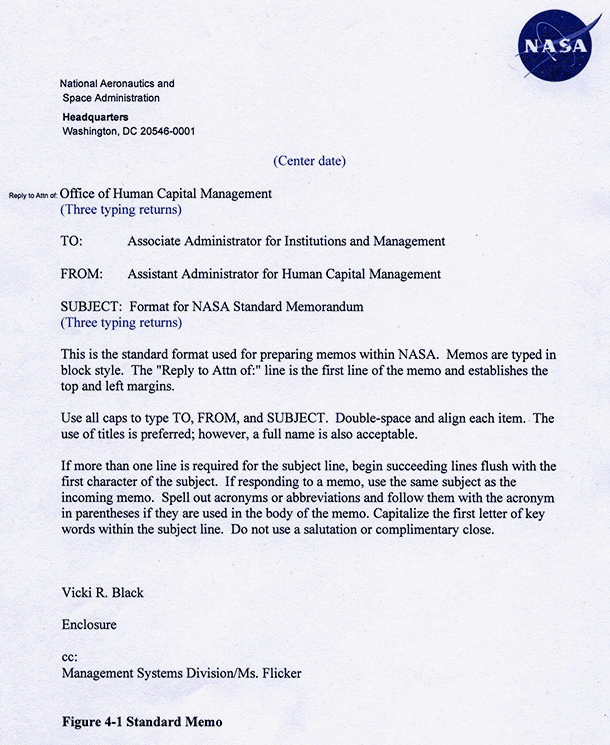
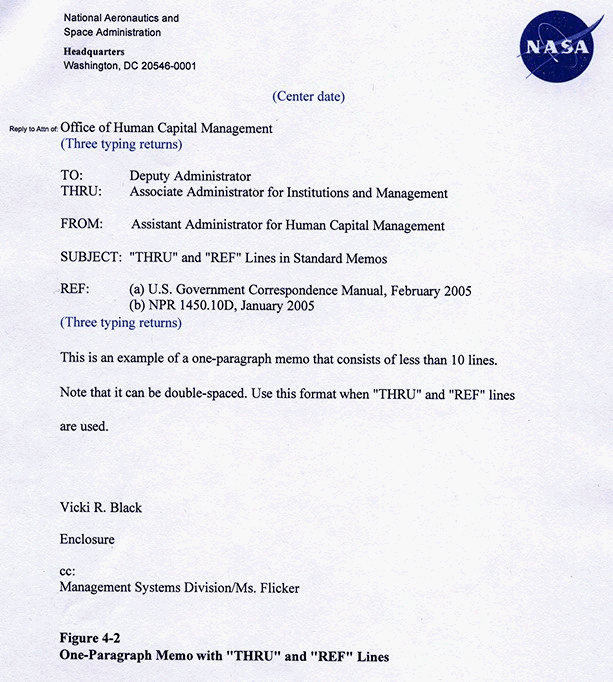
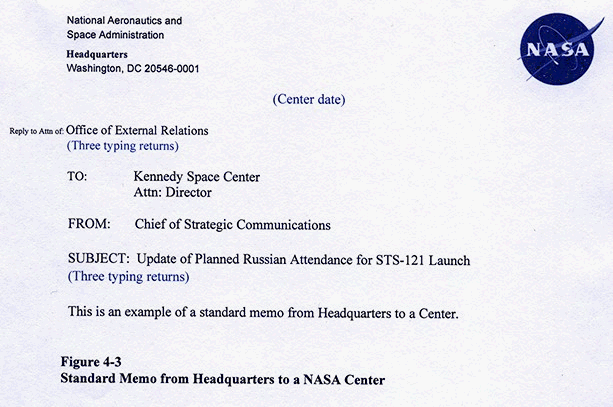
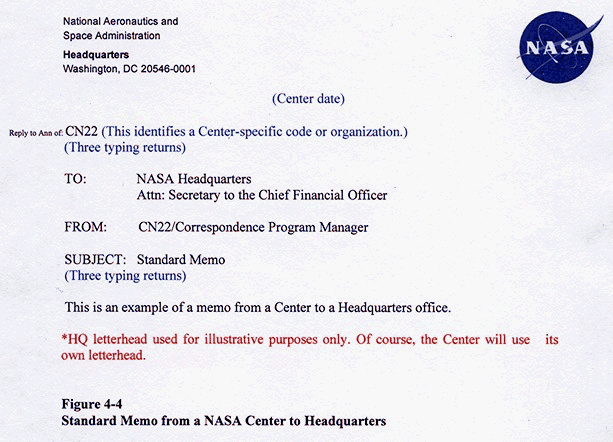
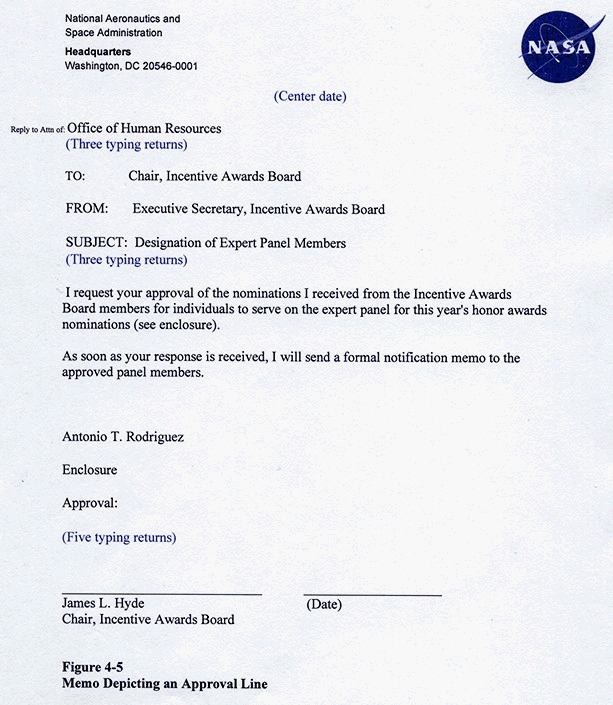
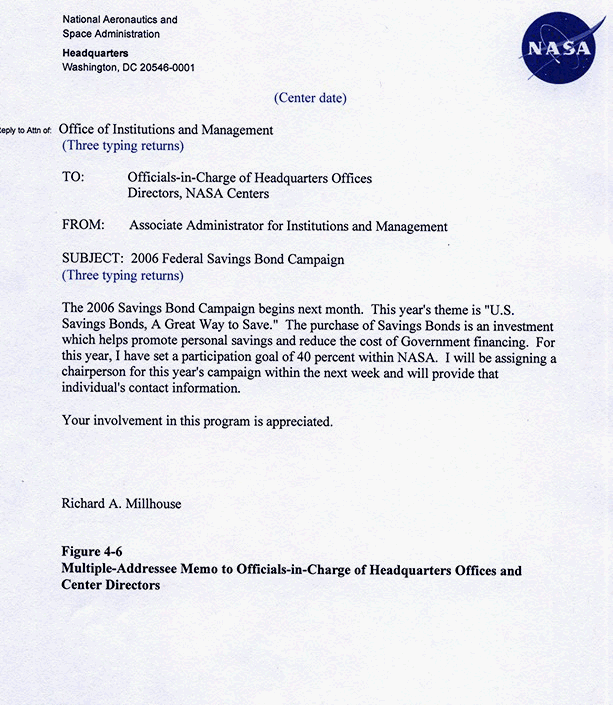
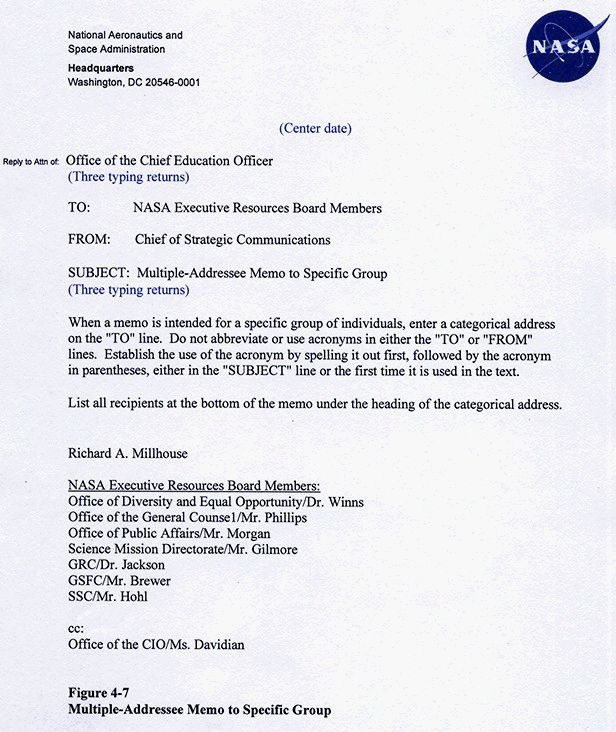
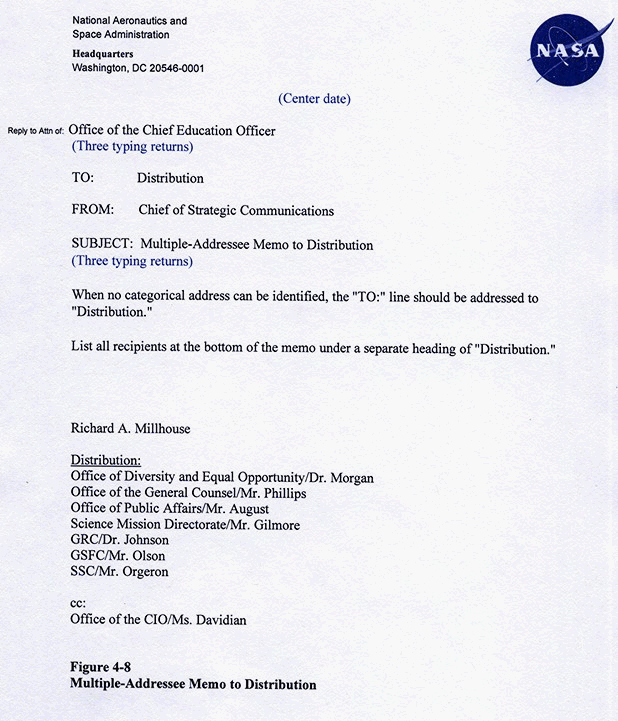
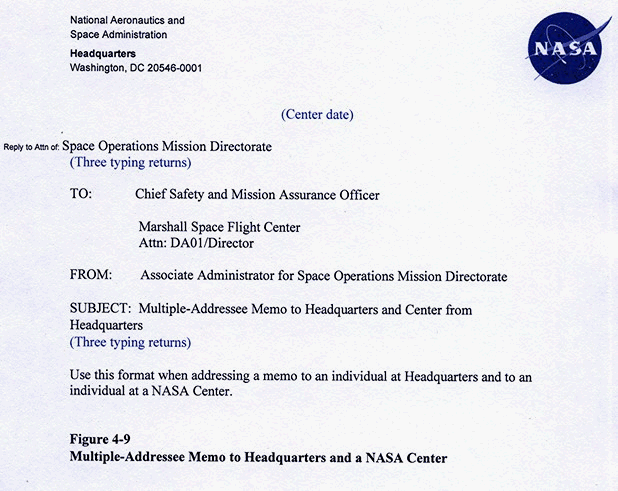
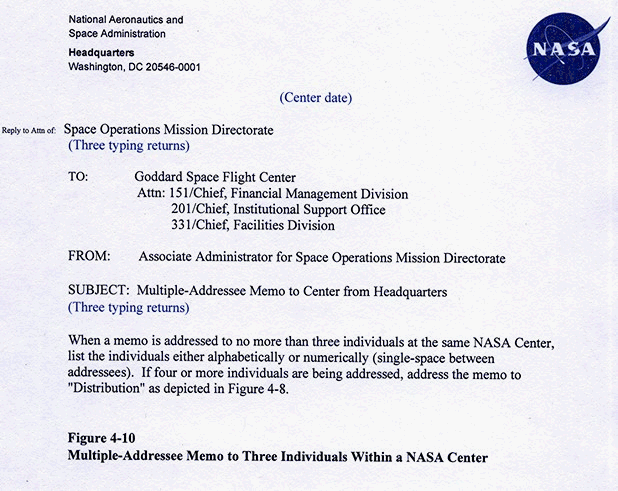
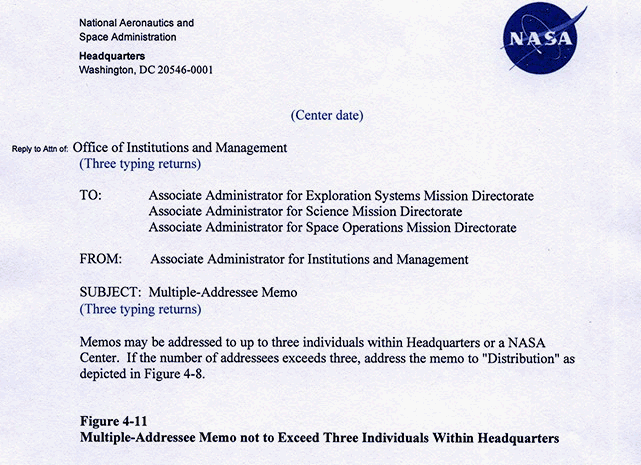
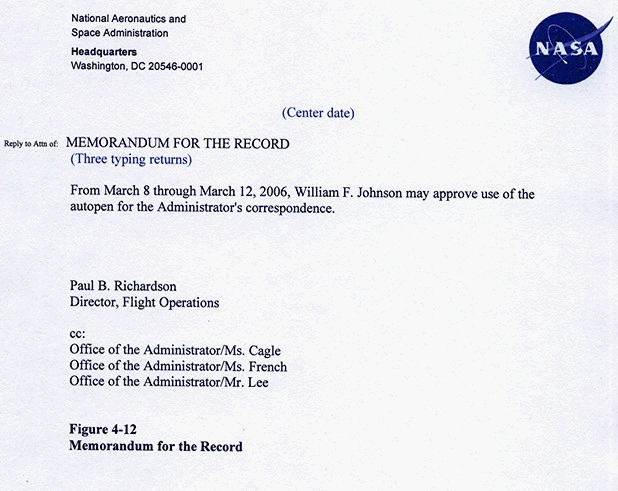
| TOC | ChangeHistory | Preface | Chapter1 | Chapter2 | Chapter3 | Chapter4 | Chapter5 | Chapter6 | Chapter7 | Chapter8 | AppendixA | AppendixB | AppendixC | AppendixD | AppendixE | AppendixF | AppendixG | AppendixH | AppendixI | AppendixJ | ALL | |
| | NODIS Library | Organization and Administration(1000s) | Search | |
This document does not bind the public, except as authorized by law or as incorporated into a contract. This document is uncontrolled when printed. Check the NASA Online Directives Information System (NODIS) Library to verify that this is the correct version before use: https://nodis3.gsfc.nasa.gov.